U.S. Department of Transportation
Federal Highway Administration
1200 New Jersey Avenue, SE
Washington, DC 20590
202-366-4000
| < Previous | Table of Content | Next > |
Walkways provide mobility along a linear path. But eventually, people need to cross roads and streets at intersections. These intersections, where the paths of people and vehicles come together, can be the most challenging part of negotiating a pedestrian network. If pedestrians cannot cross the street safely, then mobility is severely limited, access is denied, and walking as a mode of travel is discouraged.
This lesson provides an overview of several design features that are critical in order to provide for pedestrian access at intersections. Much research has been done on this topic in the past, and several design manuals provide more detail, including the Manual on Uniform Traffic Control Devices, AASHTO's Policy on the Geometric Design of Highways and Streets, and ITE's Design and Safety of Pedestrian Facilities among others.
Text for this lesson was taken from the Institute of Transportation Engineers' 1998 publication, entitled Design and Safety of Pedestrian Facilities-A Recommended Practice. Reprinted with permission.
In urban areas, two-thirds of the pedestrian injuries occur at central business district (CBD) intersections. Overall, the "intersection dash," where a pedestrian enters the street at an intersection and is seen too late by a driver of a motor vehicle is the third most prevalent pedestrian accident type, accounting for 7.2 percent of all pedestrian crashes.
The solution is to design and build intersections that:
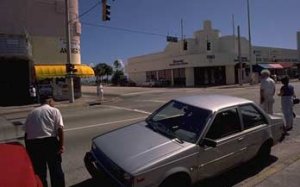
Reduced sight distances can present a serious problem for pedestrians
who wish to cross the street.
A good place to start is to develop design guidelines for intersections that are responsive to the needs of pedestrians, which can be followed whenever new intersections are built or when existing intersections are being improved or reconstructed.
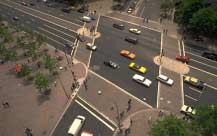
Use of colored crosswalks and median refuges makes this intersection more pedestrian-friendly.
Important intersection issues include consideration of the following:
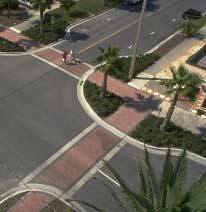
Bulb-outs reduce crossing distances for pedestrians.
Improving intersections for pedestrians involves the coordination and integration of a number of design elements, including crosswalks, curb ramps, curb bulbs, turning radii, signalization. When designing intersections:
Of the 61 different pedestrian accident types, the midblock "dart-out" type - where a pedestrian may suddenly appear between parked cars or otherwise cross a vehicular way at a random location - accounts for 13.3 percent of all pedestrian accidents. In three-quarters of these cases, the crash occurs in the curbside lane. One-third of mid-block dart-outs result in a serious injury or a fatality.
One solution is to create an ongoing retrofit program to establish crosswalks in locations that encourage pedestrians to cross in certain locations, and that also provide motorists with ra easonable expectation of where pedestrians might cross a roadway. Crosswalks are one tool that municipalities can use to accomplish both goals. Other tools include curb bulbs and medians (as discussed in this lesson).
The Institute of Transportation Engineers recommends that certain conditions may not warrant the installation of marked crosswalks, such as when the hourly peak pedestrian volume is very low (< 25 pedestrians per peak 4 hours) or when traffic volume is very low (< 2,000 Annual Average Daily Traffic [AADT]). At all other locations, or where predominately young, elderly, or handicapped pedestrians may be found, crosswalks are recommended.
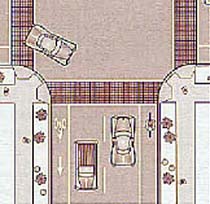
Textured crossings, using non-slip bricks or pavers, can
raise a driver's awareness through increased noise and vibration.
Crosswalks are relatively inexpensive to install. Obtaining authorization to install them, on the other hand, could take months or longer.
An informal traffic study can determine if the crosswalk program is enhancing pedestrian safety. Especially monitor locations of high pedestrian use. Review crash statistics on a regular basis.
When planning and designing crosswalks, consider these recommendations:
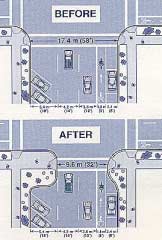
Also known as bulbs, neck-downs, flares, or chokers, curb
extensions reduce
the pedestrian crossing distance and improve the visibility
of pedestrians by motorists.
Walking across a wide street takes longer than crossing a narrow street. As a result, pedestrians are exposed for a longer length of time to the threat of being hit by a vehicle when crossing a wide street. Another problem pedestrians face when trying to cross a street is visibility. Parked cars may make it difficult for them to see oncoming vehicles and vice versa.
Also, when streets intersect at an acute or obtuse angle, or have a large curb radius, motorists can make turns at relatively high speeds. By contrast, 90-degree intersections and corners with tight curb radii tend to slow motorists down. The problem with obtuse angles is particularly bad when a vehicle on an arterial street turns onto a residential street. Pedestrians crossing the residential street adjacent to the arterial may not expect high-speed turning traffic or they may have their backs turned toward the turning cars.
The solution is to shorten the crossing distance for pedestrians. One way to effectively shorten the pedestrian crossing distance on streets where parking is permitted is to install curb bulbs, also known as curb extensions and chokers. Curb bulbs project into the street, usually for a distance equal to the depth of a typical parallel parking space, making it easier for pedestrians to see approaching traffic and giving motorists a better view of pedestrians. When motorists are better able to see pedestrians, they have a greater opportunity to stop before a crash can occur.
Decreasing crossing distances for pedestrians also provides these motor vehicle capacity benefits:
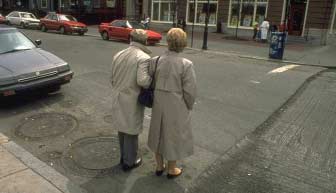
Reduced sight distances can present a serious problem for pedestrians
who wish to cross the street.
When designing curb bulbs at intersections where there is low truck traffic, consider making the corner radius as small as possible. This will have the effect of slowing down right-turning motor vehicles. Where truck traffic is present, a tight corner radius may make the turn difficult to negotiate for these vehicles. Furthermore, the constant overriding of the curb and sidewalk by rear wheels of trucks may ultimately cause damage to the curb or sidewalk or cause injury to pedestrians.
Simultaneously installing curb bulbs and changing curb radii is frequently possible since both involve moving the curb and gutter into the improved portion of the street right of way.
Where acute or obtuse intersections are encountered, such as where a residential street meets an arterial, creating an intersection that is closer to 90 degrees may also provide opportunities to reduce curb radii and create curb bulbs.
Typically, curb bulbs and curb radius changes are appropriate at a limited number of intersections. Consequently, over time, most intersections that need improvements may be upgraded for pedestrians in this fashion. As with other pedestrian improvements, the key is to develop a strategy and stick to it over a period of years. Here's how to get started:
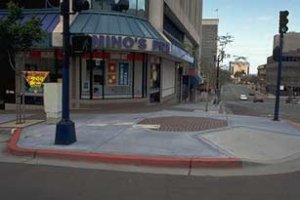
The cost of installing curb bulbs and changing the curb radii can vary considerably, depending on whether drain grates have to be moved and/or whether there are other issues that have to be addressed. For example, it may be necessary to move the conduit for a signal or relocate utility poles and light and/or sign standards.
Decide if the work is to be done by the public works department or a private contractor. In general, if only a few bulbs are involved, it may be cheaper and faster to have town or city crews do the work. If there is a lot of work to be done, it may be cheaper to use a private contractor. The key is to let the public know how long it will take to install a bulb and then deliver promptly.
Visit project sites to determine if good locations have been selected and the best design(s) is being used. Check crash records, do speed studies of cars making turns, look at the curbs to see if trucks or buses are driving over them, and ask pedestrians if they feel safer. Be a good listener and observer, and make modifications where needed.
Transportation agencies have increased curb radii over the years to keep trucks and buses from running over curbs and striking pedestrians standing on the corner; such changes also increase capacity. Unfortunately, curb radii have been increased at intersections that do not have large truck traffic or buses (e.g., in residential neighborhoods). The following are guidelines for curb bulbs and small curb radii:
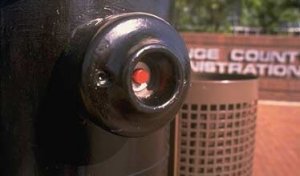
Pedestrian push buttons should be conveniently placed. Be sure existing
site features are not obstacles to reaching the button.
The public is often baffled by pedestrian signal timing and push buttons; such pedestrian features seem to vary not only from jurisdiction to jurisdiction, but also from intersection to intersection. Walk/ Don't Walk timing lengths often appear arbitrary- especially the Walk and flashing Don't Walk phases. Part of the problem stems from the fact that many walkers do not know that the flashing Don't Walk is intentionally displayed before an average person can completely cross the street. Another part of the problem may result from timing cycles that are simply too fast for slow walkers such as older pedestrians or people who are handicapped.
Another aspect of the problem may be due to the absence of pedestrian push buttons or because a call button is obscured or difficult to reach. At many intersections that do have push buttons, the Don't Walk phase is so long that pedestrians feel their pushbutton request has not been recognized by the signal system. All of these problems encourage disrespect for pedestrian signals, promote increased jaywalking, and create conflicts with motorists.
Develop policies governing pedestrian signal timing and push-button actuation to ensure fair treatment for pedestrians. Make signal timing as consistent as possible, and adopt a clear pedestrian push-button warrant. Develop a desired level of service for pedestrian waiting and push-button response times and evaluate signalized intersections to see if the pedestrian level of service at signalized intersection falls within an acceptable range.
Major issues related to pedestrians and signalized intersections include:
Making signalized intersections consistent with stated policies won't happen overnight; consider it as part of a long-term commitment to pedestrian safety. Whatever strategy is employed, use field observations to see how pedestrians react to signal timing and push buttons. Comparing a variety of configurations will help. It is possible for workable and consistent policies to be developed.
Annual Program: A comprehensive program should be established to evaluate and prioritize improvements. It should not be hard to locate those areas needing attention. In all likelihood, the public works department probably maintains a file filled with complaints from citizens.
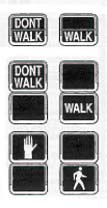 New
Signal or Signal Timing Projects: Review the pedestrian signal timing plan
for any intersections undergoing signal modification or adjustments. Keep
aware of signal work, providing appropriate suggestions. This will help signal
engineers become more sensitive to pedestrian needs.
New
Signal or Signal Timing Projects: Review the pedestrian signal timing plan
for any intersections undergoing signal modification or adjustments. Keep
aware of signal work, providing appropriate suggestions. This will help signal
engineers become more sensitive to pedestrian needs.
Resource Requirements
The peculiarities of many intersections means that a strictly policy-driven
approach may not be possible. As a result, trained personnel will be needed
to evaluate signal timing and actuation at many specific locations. Most of
the work will be done by agency crews unless there is a large enough backlog
to justify going out to bid.
Monitor intersections with modified signal timing and push buttons, and compare them with unaltered intersections. Crash reductions and/or fewer pedestrian complaints will be good indicators of whether the new policies are working. Develop a level of service for pedestrian push buttons and apply accordingly
Consider these features when providing signals that are responsive to pedestrians:
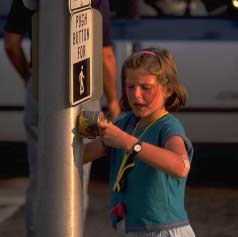
Pedestrian push buttons are often provided at locations
with intermittent pedestrian volumes to call for the WALK message
and/or extend the crossing interval.
Pedestrian refuge islands are defined as the areas within an intersection or between lanes of traffic where pedestrians may safely wait until vehicular traffic clears, allowing them to cross a street. Refuge islands are commonly found along wide, multi-lane streets where adequate pedestrian crossing time could not be provided without adversely affecting the traffic flow. These islands provide a resting area for pedestrians, particularly those who are wheelchair- bound, elderly, or otherwise unable to completely cross an intersection within the provided signal time. These refuge islands also provide a safety area for pedestrians caught in the street when a signal changes.
When evaluating whether a refuge island is needed, both crossing time and safety must be considered. For example, in suburban areas with long distances between intersections and traffic signals, a large proportion of pedestrian crossings occur at unsignalized intersections and at mid-block locations. However, with a median, a pedestrian would only have to look in one direction to cross to the median, and in the opposite direction to complete their crossing from the median to the far side of the street. Pedestrians crossing an undivided, multi-lane street may experience delays 10 times longer than the delay incurred crossing a street with a median as shown by the pedestrian crossing delay curves provided in NCHRP Report 294A.
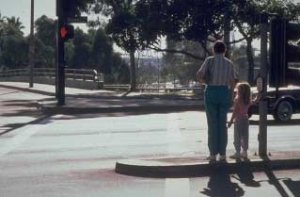
Refuge islands provide a safety area for pedestrians who cannot cross
the entire street on one cycle.
The effect of refuge islands and medians on pedestrian safety is unclear. Studies have reported both increases and decreases in accidents after pedestrian islands have been installed. There is a substantial lack of definitive information on this subject. However, a 1978 study in western Australia indicated that the rate of pedestrian accidents at a four-lane unsignalized intersection was reduced to 11.5 percent of its original level when raised median islands were installed.
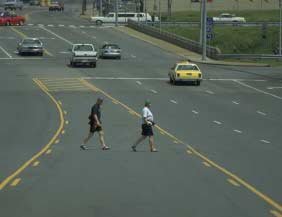
Streets with raised medians usually have lower pedestrian crash
rates.
Refuge islands can be beneficial under certain conditions and inconsequential or even harmful under others. The typical conditions where refuge islands are most beneficial include:
The typical conditions where refuge islands are least beneficial or possibly harmful include:
In areas where refuge islands are beneficial, the advantages to pedestrians are many, including:
The disadvantages of pedestrian refuge islands include:
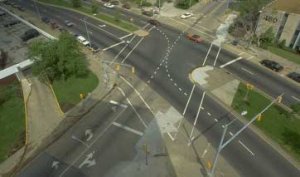
Pedestrian refuge islands can create a safer crossing for wide streets.
Pedestrian refuge islands may be installed at intersections or mid-block locations as deemed appropriate by engineering studies. Refuge islands should be considered during the design of complex intersections or streets rather than after construction has been completed. They must be visible to motorists at all times and should be delineated by curbs, guideposts, signs, or other treatments. Refuge islands should be designed to minimize the potential hazard to motorists and pedestrians alike.
Pedestrian refuge islands must be designed in accordance with the AASHTO policy and the MUTCD requirements. Design considerations should include:
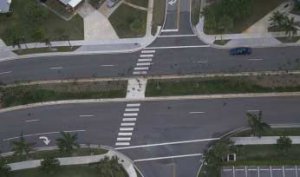
Refuge islands provide pedestrians with a resting place when crossing
roads or intersections.
The need to develop and detail pedestrian intersection improvements in a manner that can be constructed within the normal field of highway construction is an extremely important issue. Pedestrian accommodations at intersections include both traffic signal and pavement marking improvements. An exercise covering pavement marking issues was previously addressed in Exercise 14.8. With regard to signalization at intersections, pedestrian improvements typically include pedestrian signals, pedestrian push buttons, conduit/wiring, mounting brackets, and pedestrian poles. Traffic signal improvements are specified through a detailed system of standard drawings, specifications, and bid item numbers. An example plan view drawing demonstrating this method for specifying traffic signal improvements using Georgia Department of Transportation standards is provided for reference in Figure 15-1.
Develop a plan to install pedestrian signals and related improvements for an intersection in your community. The plan should be developed using nomenclature and reference standards from your State DOT. A list of standard drawings pertaining to pedestrian facility construction from Caltrans (California Department of Transportation) was previously provided in Exercise 14.8. If possible, you should obtain an intersection drawing from your local traffic engineering department. This drawing typically shows the location of existing roadway features, travel lanes, signal equipment, and utilities. In addition to preparing a plan of proposed improvements, develop an estimate of quantities needed for each construction item and prepare an engineer's construction cost estimate. You will need to utilize the following resources:
"A Comparison of the Pedestrian Safety of Median Islands and Marked Crossings," Western Roads, Western Australia, August 1978.
American Association of State Highway and Transportation Officials, A Policy on Geometric Design of Highways and Streets, Washington, DC, 1990.
Federal Highway Administration, Manual on Uniform Traffic Control Devices, Washington, DC, 1988.
ITE, Design and Safety of Pedestrian Facilities-A Recommended Practice of ITE, Washington, DC, 1998.
National Cooperative Highway Research Program, Transportation Research Board, Planning and Implementing Pedestrian Facilities in Suburban and Developing Rural Areas, NCHRP Report 294A, Washington, DC, June 1987.
Figure 15-1:
Example Traffic Signal Plan. Sugarloaf Parkway Construction Plans Lawrenceville, Georgia
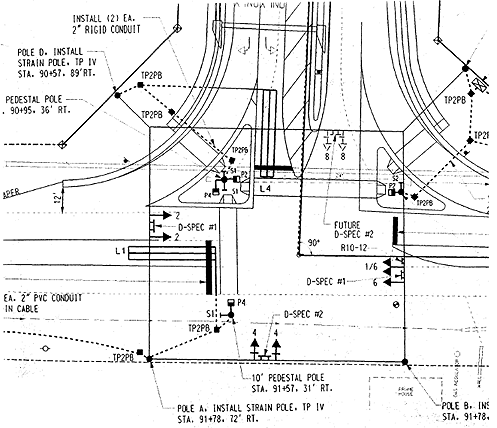
| < Previous | Table of Content | Next > |
